Darrin Gross of the Oakland Athletics Major League Baseball talks attracting and retaining sponsorship and ticket sales in a market dominated by others.
Background of Darrin Gross and the Oakland Athletics
Darrin Gross who was, at the time of presentation, the Director of Corporate Partnerships for the Oakland Athletics (OA), a Major League Baseball side, worked his way through the sport in a similar fashion to most players; that is, through the development pathway. He has been an integral part of the development of the Oakland Athletics corporate relationships and, for lack of a better phrase, off-field successes in terms of ticket sales and sponsorship attainment and retention; something which is particularly impressive when the scope of the local sports market is taken into consideration. The Oakland Athletics are a somewhat surprisingly competitive side in the MLB conference, particularly with a majority of their players (15/20, to be exact) earning the MLB minimum wage, and the club’s financial circumstances meaning they are unable to attract any high profile free agents, contributing to a lack of well-known baseball stars occupying their payroll, and as a result further increasing the level of difficulty involved in obtaining other revenue stream such as sponsorship and ticket sales.
The environment in which they operate
Gross outlines in his presentation that being surrounded by such a populated area allows for both significant advantages and disadvantages. Such advantages include:
– San Francisco being the #6 media market in the United States, meaning there is sizeable level of potential exposure for the OA’s around the country and the world
– Their DMA (Designated Market Area – admittedly a phrase/concept which I was completely unaware of before this presentation) consists of roughly 6 million people, not including surrounding areas such as Sacramento (not in their DMA) who contribute some further 1 million people
– San Francisco area has been rated as one of the top #10 tourist draws in the world, therefore increasing the average potential to draw in crowds from over the world who are looking to experience a different sporting environment
The disadvantages, whilst also being greater in number, are arguably more influential on the corporate operations for the OA’s. Gross explains that such disadvantages are recognised by the club but are unable to be used as excuses, therefore increasing and fostering the creativity with which they market to the people and corporate populations. Such disadvantages include:
– Their venue is aged, outdated and somewhat run down
– Their stadium is shared with the NFL club the Oakland Raiders (a team with a bit of a Collingwood reputation – that is, most hated in the league, with hooligan fans) meaning the turf suffers higher than average wear and tear
– As mentioned earlier, they have one of the 5th lowest budgets for player salaries in the league (MLB does not operate salary cap policies), making attracting high profile players difficult
– There are 17 other teams, clubs and events (from a variety of sports) within 90 miles of the OA’s, who are therefore competing for the same sponsorship dollars and population for ticket sales
The existence of such disadvantages means there is an increased reliance on the advantages which the OA’s do have over other teams in the area and league. Such advantages are either already in existence or have been developed by the baseball club in an attempt to make their home games a more marketable product. These include;
– Huge parking capacities
– Close by public transport (established through a sponsorship deal) which drops patrons off right outside the gates of the stadium
– The stadium, despite being aged, is a great and historic arena which has a brilliant atmosphere once seated and watching baseball
– The OA’s have a long and remarkable history of baseball excellence and successes
– The weather is good for a majority of the playing season
All points stated above have been used by Darrin and the OA’s to celebrate what they are, and their points of difference towards competitors, rather than being forgotten in an attempt to try and be what they are not.
Key strategies, campaigns and policies
During the presentation, Gross outlines a total of ten separate strategies which have been employed at the OA’s to make them stand out from their competition. I have expanded on a couple which I would consider to be more significant and noticeable strategies below:
- The establishment of events which are designed to ‘marry’ the clubs partners to each other
– This involves creating events whereby partners are able to mingle with each other, therefore increasing their own business opportunities. In particular, Gross explained a situation whereby Krispy Kreme doughnuts became aligned with a wholesale sponsor to sell their product in their stores.
– Examples of events include suite nights for representatives from different partners to come together at a match, bocce competitions, and golf days.
- Well trained and thoughtful staff
– Ensuring staff (particularly game day staff) who interact with the consumers on a one-on-one level are aware of the impact they can have on the experience of the patron in attending their matches, means they are more likely to provide a positive experience for them. It is important for all staff to understand their importance in providing the sport service to the customers. They have the ability to “make or break somebody’s day”.
The other strategies outlined by Gross were:
o Strategic partner rates for unsold inventory (advertising space)
o Kiosks (established in conjunction with the MLB) placed around the stadium
o Flexible ticketing exchange policies
o Value propositions e.g. free parking Tuesday’s
o Special entrances for ‘VIFs’ (Very Important Fans – season ticket holders)
o High level seating (Diamond seating and Field Box seating)
o Establishment of a corporate service team
o Partner inclusion in Social Media campaigns
The implications on the Australian sport marketing industry/landscape
Gross’s talk outlines that despite being in an area which is highly competitive, there are many ways to stand out in front of your competitors to win sponsorship. Australia’s sporting industry, whilst quite vast and spread out, is arguably a hotly contested industry, particularly with the rise of sports such as A League soccer, the introduction of the Big Bash League, and the rejuvenation of the Trans-Tasman Netball League; the ANZ Championship – not to mention the competition between the NRL and the AFL. Gross demonstrates the innovation used in the OA’s marketing techniques which is most definitely the reason they are still alive and successful today, and there is no reason why these practices cannot be replicated within the Australian sports industry.
Three key takeaways from the talk
Following listening to the talk, I determined the following three practices which could be implemented right away to help improve a sporting club or league within Australia. They are;
– The development of kiosk technology to help ease the purchasing and collecting of tickets,
– The establishment of corporate service teams to help prioritise the service of corporate guests, and;
– Strong and bargained value propositions to help encourage attendance at quieter games.







